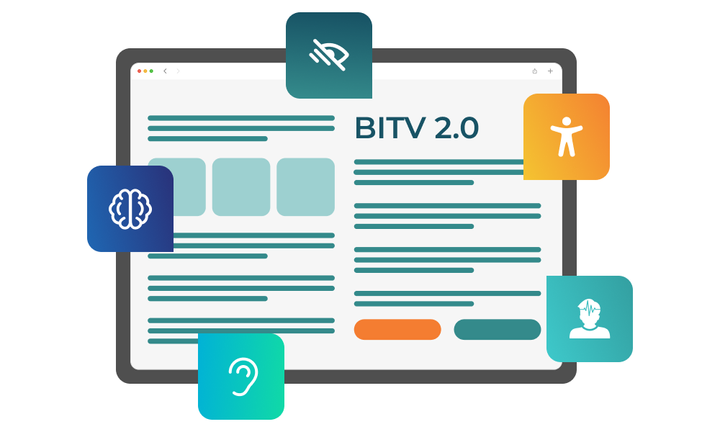European Accessibility Act: what and when will change for Digital Accessibility

Digital Accessibility today is much more than just a fashionable and useful trend. It is a necessity. Back in 2019, the European Union took a huge step to guarantee inclusiveness in various spheres of life by adopting The European Accessibility Act (EAA). By June 2022, each member state of the European Union had to develop the necessary laws. And their implementation should be ensured by June 28, 2025.
Therefore, in a few months, the EAA will be a REQUIREMENT, not a directive, that is, it will be a mandatory rule for every business that operates or provides services in the market in 27 countries of the European Union!
At the same time, consumers can file complaints with national courts or authorities if companies and organizations do not comply with the new rules. The EU is home to more than 448 million people.
What is the European Accessibility Act?
This new rule was adopted in April 2019 to help hundreds of millions of people with disabilities in the European Union. This directive also applies to the elderly, pregnant women, and other people with temporary functional limitations.
The European Accessibility Act makes it easier for all Europeans to use digital services, no matter what their needs are.
The EAA was designed to improve the internal market by removing the barriers created by different rules in different countries. These differences made it harder for companies to compete and grow.
The EAA obligations apply equally to both public and private sector entities. A product manufacturer or service provider must make an accessibility declaration and label its product accordingly.
What industries, products, and services are covered by the EAA?
This directive applies to the following products and services placed on the market after June 28, 2025:
- Computers and operating systems (including desktops, laptops, smartphones, and tablets).
- Payment terminals and self-service terminals (especially: ATMs, ticket machines, registration machines, and screens.
- Emergency communications must include real-time text and general talk services when they provide video. All these communications must be synchronized.
- Audiovisual media services (websites, apps, e-books, mobile services, connected TV, and related equipment).
- Air, bus, rail, and water passenger transportation services (online and offline services).
- Banking services.
- E-readers (electronic devices for reading books).
- E-commerce.
As you can see, the European Accessibility Act covers a very wide range of goods and services. This directive applies to any business that wants to trade in the EU, wherever it is, even if it is registered outside the EU.
What is NOT covered by the EAA?
This directive does not apply to the following digital content on websites and mobile applications:
- pre-recorded multimedia published before June 28, 2025;
- office file formats published before June 28, 2025;
- third-party content that is not funded, developed, or controlled by the relevant business entity;
- content of websites and mobile applications that qualify as archives, i.e. they contain only content that has not been updated or edited after June 28, 2025.
The requirements and obligations of the European Accessibility Act do not apply to microenterprises. A microenterprise is an enterprise that employs less than 10 people and has an annual turnover or balance sheet of less than EUR 2 million.
What is accessibility as defined by the EAA?
First, let us remind you that Digital Accessibility is a civil right of people with disabilities. Thus, ensuring it can save you from potential legal problems, and lawsuits filed for discrimination as a result of accessibility audits. We have previously written about this in our article: Why is mobile accessibility so important?.
The EAA defines persons with disabilities according to the UN Convention on the Rights of Persons with Disabilities, which was adopted in 2006 and has been ratified by all EU countries. The Convention defines persons with disabilities as those who have long-term impairments that may hinder their participation in society.
The concept of "persons with disabilities" as defined in this Directive includes persons who have any physical, mental, intellectual, or sensory impairment, age-related impairment, or other reason relating to the functioning of the human body, whether permanent or temporary, which, in interaction with various barriers, results in a restriction of their access to products and services.
The annexes to the Directive set out requirements for accessibility of various products and services. In particular, they refer to the four principles of accessibility of websites and mobile applications, i.e. the four basic principles of WCAG (Web Content Accessibility Guidelines):
- Perceivable: Information and user interface components should be presented to users in a way that they can perceive. Provide text alternatives to all non-text content, allowing people to alter it into other forms they need, such as large print, Braille, speech, symbols, or simpler language.
- Operable: User interface components and navigation should be manageable and workable. Make it easy for users to operate functions by using inputs other than the keyboard.
- Understandable: The information and operation of the user interface should be clear and easy to understand.
- Robust: The content must be sufficiently robust to be interpreted by multiple user agents, including assistive technologies.
How does the EAA change business obligations?
- When selling in the EU, manufacturers must make sure their products are accessible. Manufacturers must complete technical documentation, pass a conformity assessment, and draw up an EU declaration of conformity with the CE marking if successful.
- The CE marking must be affixed to the product or its data label in a visible, legible, and indelible place. The CE marking shall be affixed before the product is placed on the market.
- The technical documentation and the EU declaration of conformity must be kept for five years after the product is placed on the market.
- Manufacturers shall indicate their name, registered trade name or registered trademark, and the address at which they can be contacted on the product or, if this is not possible, on its packaging or in a document accompanying the product. Contact information must be provided in a language that is easily understood by end users.
- Manufacturers should ensure that the product is accompanied by safety instructions and information in a language that can be easily understood by consumers and other end users. Such instructions and information, as well as any labeling, must be clear and conspicuous.
What are the consequences of non-compliance with the EAA?
The regulatory consequences of non-compliance with the European Accessibility Act include fines and other penalties, although the specific nature and amount of these fines are left to the discretion of each EU member state.
So, countries will have different sanctions. Some countries have set fines for companies and individuals, while others have set jail time for certain corporate positions. Some states are still deciding on the number of fines.
In any case, fines under the EEA Directive depend on how much a company doesn't comply with the rules.
After June 2025, there will also be negative consequences for not following the EAA Directive:
- Litigation: You may face lawsuits from individuals or human rights groups representing people with disabilities.
- Reputational damage: You will damage your reputation and face negative publicity.
- Loss of customers: You will lose customers if your products or services are inaccessible. Companies that prioritize accessibility will attract a diverse customer base.
- Exclusion from procurement processes: More public and private organizations will require EAA compliance. If you don't meet the requirements, you may be excluded from public procurement.
Implementing digital accessibility: general EAA requirements
The detailed accessibility requirements for all products and services covered by the European Accessibility Act are contained in Annex 1.
According to this document, in particular, products must be designed and manufactured in such a way as to maximize their intended use by persons with disabilities and must be accompanied, where possible, in or on the product by accessible information about their operation and accessibility features.
- Information provision requirements
- Product information must be presented in a way that is clear and easy to understand. This includes using the right font size, shape, and spacing.
- If a product has information but it is not self-explanatory, the information must be made available in accessible formats. This can be done within the product or via the interface. If the information is on a screen to explain the product, it should be in text formats that can be made into alternative formats and presented in different ways and through more than one sensory channel. It should also have an alternative presentation of non-textual content. This includes a description of the product's user interface, processing, control, and feedback. It also includes product functionality, software and hardware interfaces, and assistive devices. A list of tested assistive devices with the product shall be included in the description.
- Design of user interface and functionality
Products must be designed so that disabled people can use them easily, including the user interface:
- if a product helps people communicate or get information, it should use different senses. This includes giving options for seeing, hearing, speaking, and feeling;
- if a product uses speech, it should also provide other ways to control it;
- the product must have flexible magnification, brightness, and contrast for communication, information, and operation. It must also be compatible with other apps and devices to navigate the interface;
- if a product uses color for any reason, it must provide an alternative color;
- if the product uses sound signals to convey information, indicate an action, require a response, or identify elements, it must provide an alternative to sound signals;
- if the product uses visual elements, it must provide flexible ways to improve visual clarity;
- products using audio must let users control volume, speed, and advanced audio features like reducing interference and improving clarity;
- if the product requires manual operation, it should provide consistent control and alternatives to fine motor control. It should also use tactilely visible parts;
- the product should avoid operating modes requiring long range and high strength;
- the product must avoid causing photosensitive attacks;
- the product must protect the user's privacy when they are using accessibility features;
- the product must provide an alternative to biometric identification and control;
- the product must ensure consistency of functionality and provide sufficient and flexible interaction time;
- the product must provide software and hardware to interact with assistive technologies
- where the product uses audio or sound signals, it must be compatible with assistive devices and technologies available across the EU, including hearing technologies such as hearing aids, telecoils, cochlear implants, and assistive listening devices;
- electronic reading devices should provide text-to-speech technology, etc.
- Support services
If available, support services (help desks, call centers, technical support, relay services, and training services) should provide information on product accessibility and compatibility with assistive technologies in accessible communication modes.
The EU digital accessibility examples of implementation:
- Providing e-files that can be read by a computer using screen readers so that blind people can use the information.
- Include subtitles when providing videos with instructions.
- Ensure that a blind person can use a file by printing it in Braille.
- Supplement the diagram with a text description that identifies the main elements or describes key actions.
- Ensuring that people with hearing impairments can write and receive text interactively and in real-time.
- Ensure that a person with dyslexia can read and hear text at the same time.
- Making the user interface of a payment service voice-activated so that blind people can make online purchases independently.
- Providing text descriptions of images, providing all functionality from the keyboard, giving users enough time to read, creating a predictable look and feel for the content and its functioning, and ensuring compatibility with assistive technologies so that people with different disabilities can read and interact with the website, etc.
Looking for help?
Speak to our team about how we can help you prepare for EAA by testing your products and services.
To provide the best user experience, we deliver effective Accessibility Analysis with a customer-centric focus. Welcome!
FAQ
Why is Digital Accessibility necessary?
Digital accessibility is a civil right of people with disabilities. All people should have equal access to products or services, regardless of existing or potential limitations. This right is now protected by law in the EU.
What is Digital Accessibility?
Digital accessibility means that everyone, regardless of abilities and disabilities, can use a Web site, application, and other digital environment.
What will happen when the EU introduces the European Accessibility Act in June 2025?
Digital Accessibility will become a legal requirement for businesses (except for microenterprises) in all 27 EU member states starting in June 2025.
What is the European Accessibility Act?
It aims to improve the functioning of an internal market for accessible products and services, eliminating barriers due to differences in national legislation.


